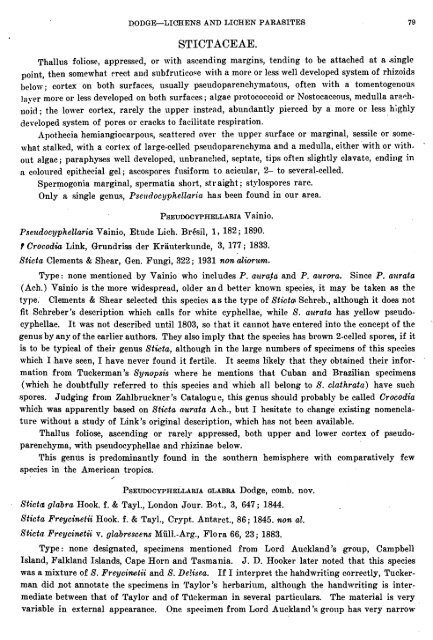Create successful ePaper yourself
Turn your PDF publications into a flip-book with our unique Google optimized e-Paper software.
DODGE--<strong><strong>LICHEN</strong>S</strong> <strong>AND</strong> <strong>LICHEN</strong> <strong>PARASITES</strong> 79<br />
Thallus foliose, appressed, or with ascending margins, tending to be attached at a single<br />
point, then somewhat erect aiid subfmticose wilh a more or less well developed system of rhizoids<br />
ll~lo\~; cortex on both surfaces, usually psendoparenchymatous, often with a tomentogenous<br />
]aver more or less developed on both surfaces ; algae protococcoid or Nostocaceous, medulla arachiioid;<br />
the lo\ver cortex, rarely the upper instead, abundantly pierced by a more or less highly<br />
developed system of pores or cracks to facilitate respiration.<br />
Apothecia hemiangiocarpous, scattered over the upper surface or marginal, sessile or somewhat<br />
stalked, with a corlex of large-celled pseudoparenchyma and a medulla, either with or without<br />
algae; paraphyses well developed, unbranc!ied, septate, tips often slightly clavate, ending in<br />
a coloured epithecial gel; ascospores fusiform to acicular, 2- to several-celled.<br />
Spermogonia marginal, spermatia short, straight ; stylospores rare.<br />
Only a single genus, Pse~rdocyphellariu has been found in our area.<br />
PSEUDQCYPHELLARIA Vainio.<br />
PseudocypheUaria Vainio, Etude Lich. Bresil, 1, 182; 1890.<br />
I Crocodk Link, Qrundriss der Krauterkunde, 3, 177 ; 1833.<br />
Sticta Clements & Shear, Gen. Fungi, 322 ; 2931 non diorzcm.<br />
Type: none mentioned by Vainio who includes P. azcraja and P. azirvra. Since P. a?crata<br />
(Ach.) Vainio is the more widespread, older and better known species, it may be taken as the<br />
type. Clements & Shear selected this species as the type of Stictc~ Schreb., although it does not<br />
fit Schreber's description which calls for white cyphellae, while S. azirata has yellow pseudocyphellae.<br />
It was not described until 1803, so that it callnot have entered into the concept of the<br />
genus by any of the earlier authors. They also imply that the species has brown 2-celled spores, if it<br />
is to be typical of their genus Sticta, althongh in the large numbers of specimens of this species<br />
which I have seen, I have never found it fertile. It seems likely that they obtained their information<br />
from Tuckerman's Synopsis where he mentions that Cuban and Brazilian specimens<br />
(which he doubtfully referred to this species and which all belong to S. clathrata) have such<br />
spores. Judging from Zahlbruckner's Catalogue, this genus should probably be called Crocodia<br />
which was apparently based on Sticta aurata Ach., but I hesitate to change existing nomenclature<br />
without a study of Link's original description, which has not been available.<br />
Thallus foliose, ascending or rarely appressed, both upper and lower cortex of pseudoparenchyma,<br />
with pseudocyphellae and rhizinae below.<br />
This genus is predominantly found in the southern hemisphere with comparatively few<br />
species in the American tropics.<br />
,<br />
PSEUWCYPHBLLARIA QLABRA Dodge, comb. nov.<br />
Sticta glabra Hook. f. & Tayl., London Jour. Bot., 3, 647 ; 1844.<br />
Sticta Preycinetii Hook. f. t Tayl., Crypt. Antarct., 86; 1845. non a!.<br />
Sticta. Preycinetii v. glabrescens Miill.-Arg., Flora 66, 23; 1883.<br />
Type: none designated, specimens mentioned from Lord Auckland's group, Campbell<br />
Island, Falkland Islands, Cape Horn and Tasmania. J. D. Hooker later noted that this species<br />
was a mixture of S. Preycinetii and S. De!isea. If I interpret the handwriting correctly, Tucker-<br />
man did not annotate the specimens in Taylor's herbarium, althongh the handwriting is inter-<br />
mediate between that of Taylor and of Tdckerman in several particulars. The material is very<br />
variable in external appearance. One specimen from Lord Auckland's group has very narrow

















